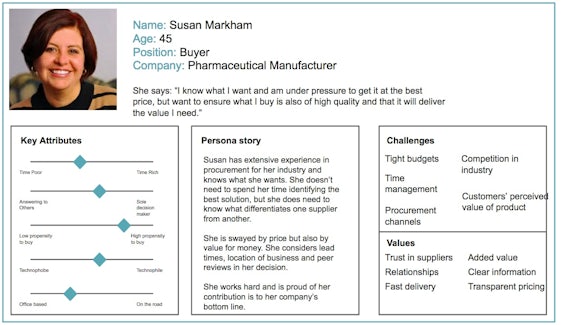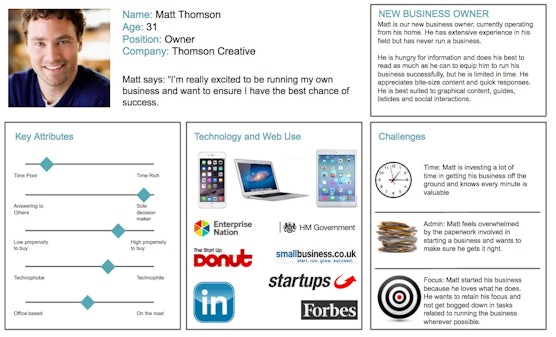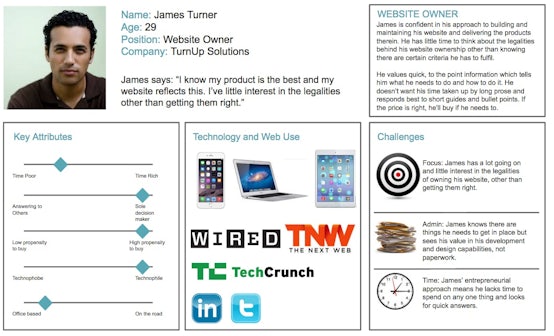Today’s digital marketer knows the importance of creating great quality content – both for the purposes of increasing search rankings and to better appeal to your audience’s needs.
In order to best meet the needs of that audience, you first need to know who that audience is. Personas are a fantastic tool for improving your understanding of your audience and visualising that in a way that can be shared and understood by everyone in your business. Persona creation follows a journey which starts at the very top of the funnel with broad understanding and that grows in detail, as shown here:

Broad audience segments: who is your target audience?
Ask yourself this question; who is your target audience? Ask others in your business; what do they say?
If they’re like many marketers today, their answers will be far too broad to be useful. They’ll say ‘homeowners’ or ‘business managers’ or ‘people who go on holiday’. But none of these accurately portrays the people you’re trying to engage with your content or your products/services.
Instead, try to be a lot more specific. This is a great task to do with your colleagues, especially your sales people who spend the majority of their time speaking to prospects and customers, or your account managers if relevant to you. Start a discussion (assisted by a flip chart and pens if this helps you) and ask yourself:
B2B
- Who are we trying to target?
- What is their age?
- What is their role?
- What industry or sector do they work in?
- Are they time rich, or time poor?
- What devices do they use in their daily lives?
- What are the biggest challenges facing them/their industry today?
B2C
- Who are we trying to target?
- What is their age?
- What is their family situation – are they married? Single? Children?
- How do they spend their spare time?
- What devices do they use in their daily lives?
- What are the biggest challenges that face them?
You’ll need to repeat this exercise until you feel you’ve covered every segment of your target audience.
What motivates them?
So now you know roughly who you’re targeting, you can start thinking about what motivates them, because our motivations are what guide our choice of content to consumer and products/services to buy.
This requires some further analysis with your team and, if possible, market research with your existing customers and prospects. You’re trying to find out:
- What are they trying to overcome by investing in your product/service – this comes back to the challenges that face them
- What about your product/service appeals to them?
- What are they thinking about when deciding whether or not to buy from you?
Ask your customers – why did you buy from us?
Common motivations might include:
- Time saving/efficiencies
- Money saving
- Personal development
- Professional development
- Care giving
Repeat this exercise with every segment of your target audience that you identified in the first stage.
No more segments – create individuals
The final step to persona creation is to take each one of your segments and your understanding of their motivations and combine them into a fictional individual person that will represent that segment and all of its complexities.
This isn’t as daunting as it may seem. You’re simply creating a person to whom you can attribute the characteristics of the entire segment, and then fill out with individual attributes like a name, a photo and a background.
Still not sure? Here are a few example personas:



As you can see, we’ve included a number of sections within a one-page overview that represents an individual person. We’ve been able to conceptualise what this person might do, the places on the web they visit, whether they are time rich or time poor, their propensity to buy, their attitude to technology and so on.
By incorporating all of this information, we better equip ourselves and our teams to talk about very complex audience segments using a simple name. For example, back when I worked for Crystal Ski, we had a segment we were targeting of 18-35-year-olds; we created a persona for this segment, named him Dylan and then through all future marketing discussions, we were able to ask ourselves ‘is this right for Dylan?’ and ‘would Dylan like this?’ – much easier to work with than having to ask ourselves if the 18-35 market would like what we were doing because it reduced the complexity of this question into something we could easily manage and discuss.
What to do with your personas
Once you have your personas and you’ve agreed them with your team, you can start using them in your marketing strategies and content plans. We wrote about how to use personas in content marketing strategies here.
It’s important you keep your personas up to date and that you do use them in your business. They can help with marketing strategies, customer service management, product development and so much more. Of course, it’s not an exact science and people might design their personas differently.



